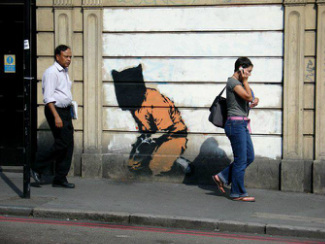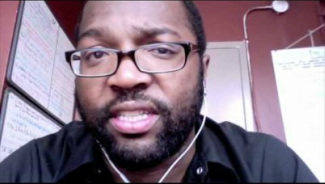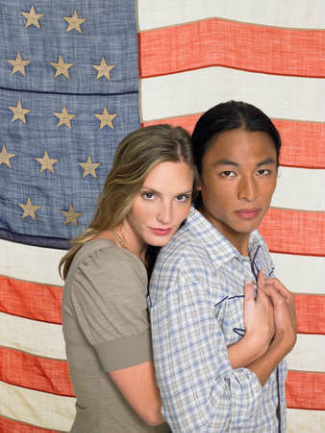 __Tags: government/the state, immigration/citizenship, theory, war/military, violence, bare life, biopolitics, guantanamo bay, gitmo, giorgio agamben, terrorism, torture, 00 to 05 mins Year: 2011 Length: 4:16 Access: NBC News Summary: Consider for a moment a patient whose brain activity has ceased but whose other organs continue to function uninterrupted. From the standpoint of modern science, the patient is merely a collection of interdependent biological mechanisms—one which pumps blood, one which oxygenates it, and another which filters it. Though once a person, the patient could now be deemed merely bare life, and as such, a physician could conceivably invoke a cardiac arrest without being accused of homicide. Prior to brain death, the patient lived a life which law sought to protect; a life that could not be killed without legal consequences. After brain death, the patient could be killed but no longer murdered. Giorgio Agamben, in his book Homo Sacer: Sovereign Power and Bare Life, examines the social movement of this biopolitical threshold, from a politically qualified life that is protected in law to one which is beyond law and can no longer be murdered. The protagonist of his book is homo sacer (the "sacred man," who may be killed and yet not sacrificed). In the book, Agamben is actually less concerned with patients facing brain death and what happens within the walls of hospitals, and instead, he focuses on the concentration camp, which he deems to be the absolute paradigm of modern political space. It is in the space of the camp where inhabitants' bodies are stripped of their status as citizens and reduced to bare life; their bodies become what is at stake in political strategy. They have no rights to legal counsel, for example, and are beyond the reach of habeas corpus. The above clip features an interview with Muhammad Saad Iqbal Madni, who was detained at Guantanamo Bay Naval Base (GITMO). Madni recounts his experience of being mistakenly captured and shipped to GITMO. He was kept in a refrigerated unit, and deprived of sleep. After 192 days of experiencing chronic pain, he finally unsuccessfully attempted suicide. As Agamben argues, he and the other detainees at GITMO have been reduced to bare life, each a homo sacer in that they occupy a biopolitical space where they are confronted by power without any protection or mediation. Their bodies are but biological mechanisms to be manipulated by power; to be tortured or even prevented from dying. Madni's testimony can be used to provoke discussion about concentration camps as spaces outside of law, and in particular, Giorgio Agamben's idea about the camp as a biopolitical space. Submitted By: Lester Andrist
2 Comments
 Paul Flores Tags: art/music, immigration/citizenship, nationalism, social construction, race/ethnicity, theory, war/military, culture, latino/a, poetry, racism, stuart hall, symbolic interaction, subtitles/CC, 00 to 05 mins Year: 2010 Length: 2:18 Access: YouTube Summary: I first started using Paul Flores' spoken word poem with adult intermediate English language learners as an example of an activity called "list poems," where students explore different ways of expressing descriptions with one adjective (here, "brown"). The students write their own list poems, we share them, and then we talk about how meaning is social—how the context in which the descriptor is used, the social interaction itself, and the ways the participants interpret both the words and the interaction, shape the meanings made of the words. In teaching sociology, I would place this activity in a discussion of social theory—perhaps in a discussion of social constructionism, symbolic interaction, or cultural studies. Stuart Hall, for example, describes the making and sharing of meaning as a social process. It is possible to see the social process of meaning-making here in the different feelings one might get from the poem when reading it silently as compared to watching it performed, or when reading/viewing it alone as compared to reading/ viewing it with others. The poem can be read at www.marcusshelby.com. Submitted By: Margaret Austin Smith  Baratunde Thurston expresses a double consciousness Baratunde Thurston expresses a double consciousness Tags: du bois, immigration/citizenship, inequality, prejudice/discrimination, race/ethnicity, theory, double consciousness, jim crow, white supremacy, 06 to 10 mins Year: 2011 Length: 7:05 Access: YouTube Summary: In this YouTube video, Baratunde Thurston vehemently declares the release of President Obama’s birth certificate an outrage and indicative of the continued existence of a white supremacy in the United States. He discusses the implications and meaning behind the release of the birth certificate, and briefly discusses the messages conveyed to the American public through the wealthy White man who took credit for stirring up the Birther controversy, Donald Trump. He argues that the demand that President Obama release his birth certificate in order to prove he is eligible to run for the Presidential office is racially motivated. One could liken the request for Obama to produce a birth certificate to similar demands on Black Americans to pass literacy tests in order to vote during the Jim Crow era. This video could be used to introduce students to Du Bois's concept of a double consciousness. In The Souls of Black Folk, Du Bois wrote, "One ever feels his two-ness—an American, a Negro; two warring souls, two thoughts, two unreconciled strivings; two warring ideals in one dark body, whose dogged strength alone keeps it from being torn asunder" Du Bois was articulating the experience of African Americans as being both insiders and perpetual outsiders to the nation; as being American but the wrong type of American. Thus, even after being elected to the highest, most respected American office, Barack Obama was still asked to prove that he belongs to the American nation. Submitted By: Beatrice Sorce  Tags: discourse/language, immigration/citizenship, race/ethnicity, comedy, representation, stereotyping, 00 to 05 mins Year: 2008 Length: 1:40 Access: ComedyCentral.com Summary: In this short clip from his stand-up performance on Comedy Central's "Live at Gotham," Hari Kondabolu discusses the racism often aimed at Mexican immigrants in the form of stereotypes, or unreliable generalizations about all members of a group that do not recognize individual differences. A stereotype can be a claim about an essential personality trait of all people in a group, as when all Mexicans are derided as lazy. It can also be a claim about the motivations or objectives of all people in a group, as when someone suspects Mexicans are taking all "our" jobs. Kondabolu jokes about the logical contradiction suggested in the idea of lazy Mexicans who are all after American jobs. But I think Kondabolu also puts his finger on a common feature of stereotypes. Even if Mexican immigrants could debunk one generalization by achieving exceptionally high levels of employment, they would only be confirming another—i.e., their greedy pursuit of American jobs. Thus stereotypes belong to a system of ideas; one which is not designed to be overthrown, but instead to stabilize power and privilege. Note that this clip contributes to The Sociological Cinema's growing collection of comedy clips that are useful for illustrating or beginning a discussion about sociological concepts. Submitted By: Lester Andrist  Multi-racial and multi-ethnic identities are on the rise Tags: children/youth, community, demography/population, immigration/citizenship, marriage/family, multiculturalism, nationalism, race/ethnicity, social construction, 00 to 05 mins Year: 2011 Length: 5:16 Access: New York Times Summary: This video accompanies a New York Times article about mixed race students on college campuses in America. Profiling students at the University of Maryland, young adults speak out about multi-racial and multi-ethnic identities, relationships, and "racial distinctions of behavior" (as one student puts it). Driven by increasing immigration and interracial marriages, young people today represent a significant and unprecedented demographic shift in the United States. Students respond to this changing environment by raising awareness about multi-racial and multi-ethnic issues and creating a safe space for a multi-cultural community on college campuses. This clip would be useful for initiating class discussions around racial and ethnic identities, social constructions of race, as well as a critical conversation around racial and ethnic behaviors, interactions and performances (stemming from the student's remark about "racial distinctions of behavior"). Finally, students can use the clip to contemplate the future of race and ethnicity in America, and the potential for change. Do students think racism will disappear as America becomes increasingly multi-racial and multi-ethnic? Submitted By: Valerie Chepp  Tags: discourse/language, immigration/citizenship, prejudice/discrimination, race/ethnicity, racism, 00 to 05 mins Year: 2010 Length: 2:58 Access: YouTube Summary: This video clip concisely explains how the media's use of the word "illegal" to describe a group of people (often undocumented immigrants) becomes racially coded language and, as such, grounds for hate crimes. This film clip is part of the Drop the "I" Word Campaign; the website offers other resources related to the video clip. I find that the clip offers students a way to explore why the terms "illegal alien" and "illegal" might be problematic and how these terms are applied to certain groups of people in ways that become racial slurs. Submitted By: Kendra Barber  Tags: immigration/citizenship, nationalism, politics/election/voting, prejudice/discrimination, race/ethnicity, social mvmts/social change/resistance, assimilation, boundary work, imagined communities, nation, tea party, 21 to 60 mins Year: 2010 Length: 23:19 Access: YouTube Summary: This clip is a short news documentary from Al Jazeera's Fault Line and features Josh Rushing's reporting on Arizona's new immigration law, known as Senate Bill 1070 (SB 1070). The new law specifies that it is a misdemeanor crime for an alien to be in Arizona without carrying registration documents, leading critics to charge that the law effectively codifies racial profiling. Rushing interviews, Arizona State Senator, Russell Pearce, Tea Party protesters, undocumented residents, and members of local law enforcement for the piece. In addition to being informative about issues regarding immigration and citizenship, the clip might be useful for illustrating the continuing relevance of nationalism and how nationalist ideologies incite people to action. At about 6:18, Rushing notes how people feel "victimized, as if the immigrants are taking something from them." The clip also provocatively connects politics with the economy and suggests that illegal immigration is a convenient scapegoat handed to people who have been hit particularly hard by the recent recession. Submitted By: Lester Andrist  Tags: discourse/language, immigration/citizenship, nationalism, politics/election/voting, prejudice/discrimination, assimilation, boundary work, imagined communities, nation, 00 to 05 mins Year: 2010 Length: 0:33 Access: YouTube Summary: This clip is a campaign ad for Tim James, the republican candidate for Governor of Alabama. The candidate notes that currently Alabama offers drivers license tests in 12 languages, and as governor, he will push to have the test given only in English. Although the candidate suggests this proposal is spurred by good business sense, one could argue that the ad is a thinly veiled attack on recent immigrants to the United States. Note that the caption under the YouTube clip mentions that the issue is important for "Republican voters who are deeply concerned about..illegal aliens." The clip can be useful for demonstrating contemporary concerns about assimilation in the United States. It may also be useful for instructors who are drawing from Anderson's Imagined Communities and want to communicate the different styles by which communities are imagined. The United States has often been imagined as an immigrant nation, but here one sees a move to imagine people who don't speak English as their first language as outsiders. Submitted By: Lester Andrist |
Tags
All
.
Got any videos?
Are you finding useful videos for your classes? Do you have good videos you use in your own classes? Please consider submitting your videos here and helping us build our database!
|
 RSS Feed
RSS Feed
